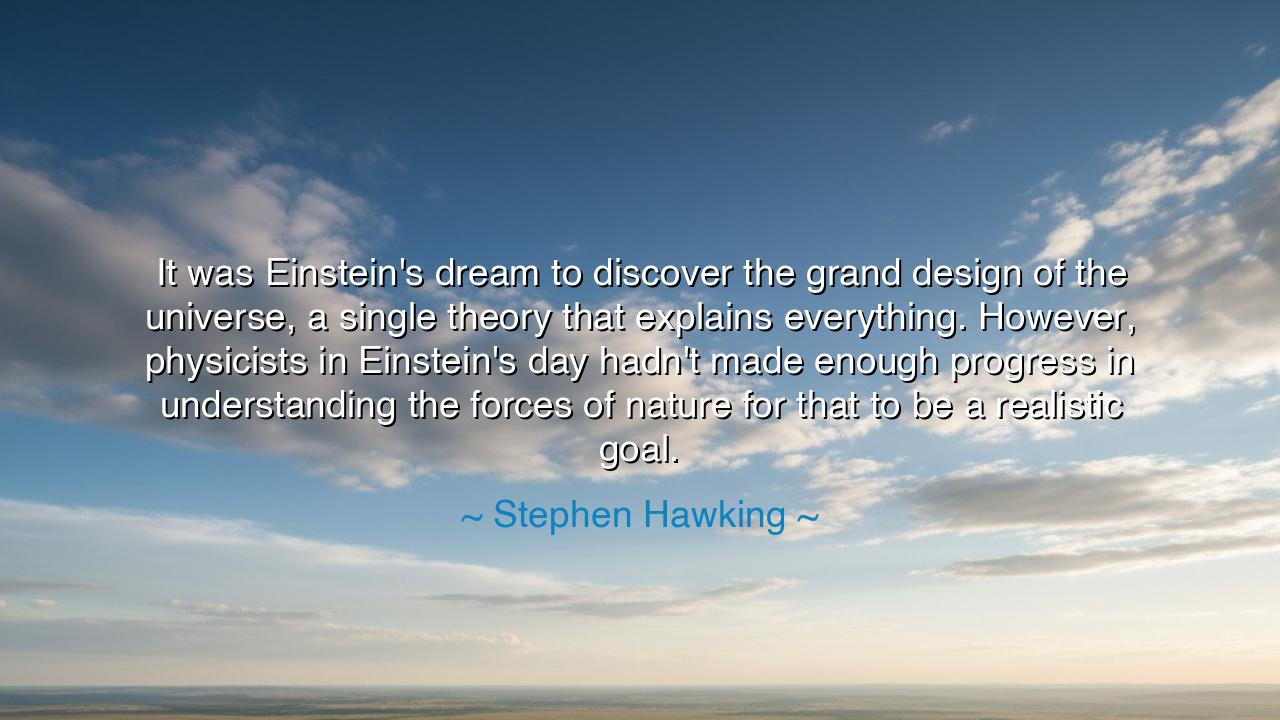
It was Einstein's dream to discover the grand design of the
It was Einstein's dream to discover the grand design of the universe, a single theory that explains everything. However, physicists in Einstein's day hadn't made enough progress in understanding the forces of nature for that to be a realistic goal.






“It was Einstein’s dream to discover the grand design of the universe, a single theory that explains everything. However, physicists in Einstein’s day hadn’t made enough progress in understanding the forces of nature for that to be a realistic goal.” Thus spoke Stephen Hawking, heir to the cosmic quest, a thinker who looked beyond the stars into the very fabric of existence. His words are both homage and reflection—a tribute to Einstein’s dream, and a meditation on the limits of human understanding. In this statement, Hawking reveals the eternal struggle of the human spirit: the desire to grasp the grand design, to find the one truth behind the many, to glimpse the mind of God through the language of mathematics.
In Albert Einstein, the world beheld not merely a physicist but a seer—a man who saw the universe not as chaos, but as order veiled in mystery. He dreamed of uniting all the forces of nature—gravity, electromagnetism, the strong and weak nuclear forces—under a single elegant principle, a Theory of Everything. To him, creation was not fragmented but harmonious, every motion of star and atom part of one cosmic symphony. This vision, this unyielding faith in unity, was Einstein’s grand design, his ultimate pursuit. Yet, as Hawking reminds us, the tools of his time were too primitive; the equations incomplete, the data too sparse. The dream was greater than the grasp, as it so often is for those who dare to see beyond the horizon of their age.
But it was this very impossibility that made Einstein’s dream immortal. For every great endeavor begins not with certainty, but with wonder. Though he could not complete his quest, he laid the stones upon which others would build. It was he who gave us relativity, who showed that space and time were not separate, but woven into one fabric—spacetime—bent and curved by the presence of mass and energy. He lifted the veil on the structure of the cosmos and showed that even light, the swiftest thing in existence, bows to the gravity of truth. Yet his theory, magnificent though it was, could not yet speak to the quantum world, that strange realm where particles flicker in and out of being like fireflies in the void. Here the unity he sought dissolved into uncertainty, and the dream remained unfinished.
Generations later, Stephen Hawking took up the same torch. He sought, as Einstein had, the unifying principle, the cosmic law that would bind relativity and quantum mechanics in one vision. In his work on black holes and the origins of the universe, he ventured deeper into the labyrinth of creation, where time begins and ends, where space folds upon itself like a living thought. Yet even he, with all the wisdom of his age, recognized the magnitude of the quest. He spoke with humility, knowing that the universe, though written in the language of reason, is vast beyond comprehension. To seek the grand design is not merely to study the stars, but to confront the limits of the human mind itself.
And yet, both men remind us of something divine within humanity: the courage to seek the infinite, knowing it may never be found. Einstein’s failure was not defeat; it was the birth of a greater vision that others would inherit. Each generation of physicists has built upon his foundation, drawing closer to the elusive truth he glimpsed. From string theory to quantum gravity, from Hawking’s radiation to the search for dark matter, the dream continues—alive in every experiment, every equation, every soul that refuses to accept ignorance as destiny. The quest for understanding is the oldest human prayer, spoken not with words but with thought.
In their story lies a lesson for all who walk the path of creation and discovery. To dream of the grand design is to accept that you may never see it whole. To reach for the infinite is to live in the tension between curiosity and humility. The wise do not despair at what cannot be known—they rejoice that there is still more to seek. For the mystery of the universe is not an obstacle, but an invitation. The stars do not mock our ignorance; they summon us to rise.
Therefore, take this teaching, children of thought and wonder: dream as Einstein dreamed, even if your tools are small and your time is short. Seek truth not for glory, but for reverence. Know that knowledge is not the end of mystery, but its beginning. For the grand design that Einstein and Hawking sought is not only written in the heavens—it is written in us. Each act of curiosity, each question asked in awe, each discovery born of patience and courage, brings us nearer to the divine harmony that binds all things.
So let us continue the journey. Let us look to the stars not as distant fires, but as symbols of what we may yet understand. For though the grand design remains veiled, it reveals itself in glimpses to those who persist, who wonder, who dare. And as long as there are minds to ask, “Why?”—the dream of Einstein, carried forward by Hawking and by all seekers after truth—shall never die.






AAdministratorAdministrator
Welcome, honored guests. Please leave a comment, we will respond soon